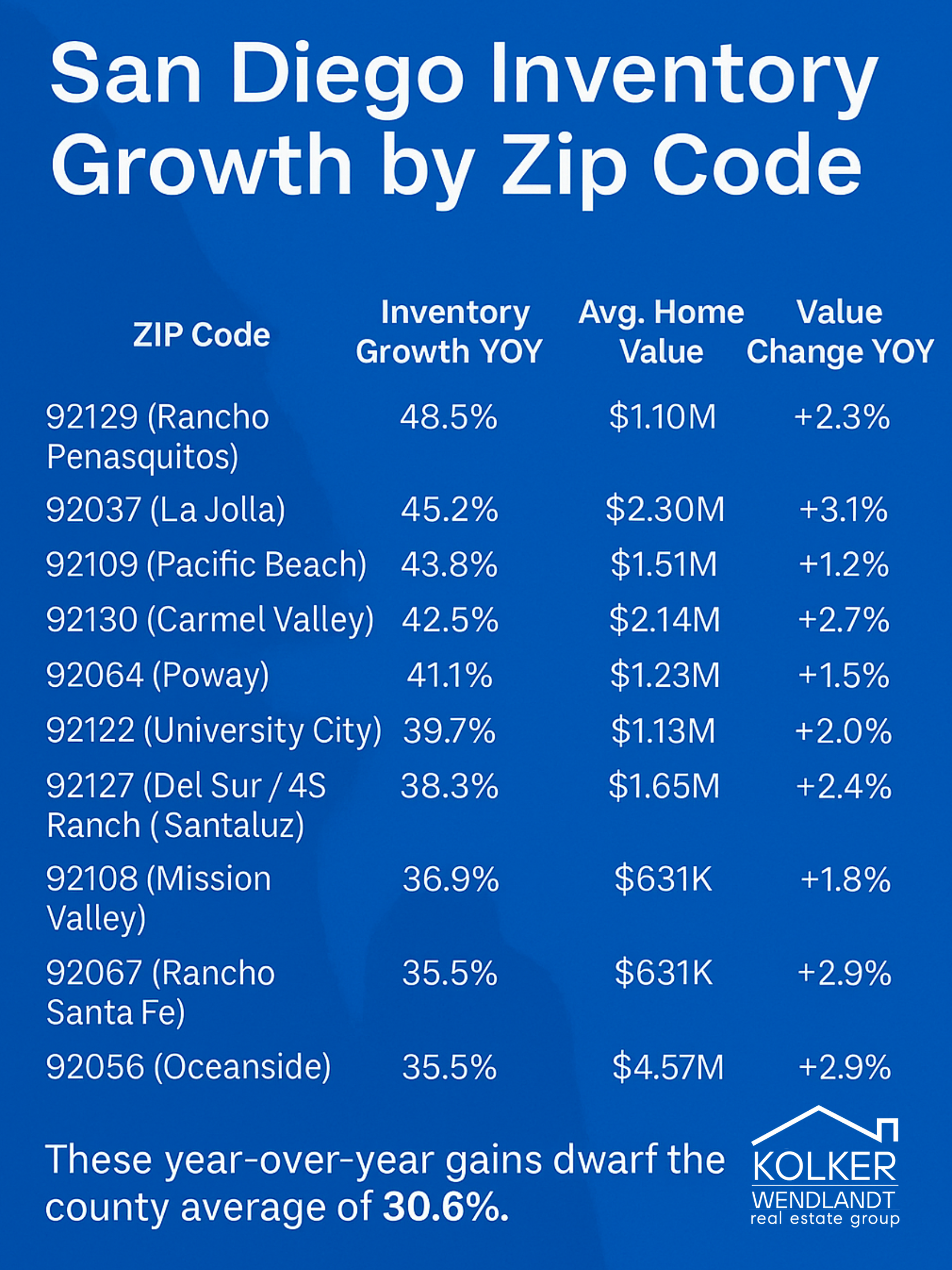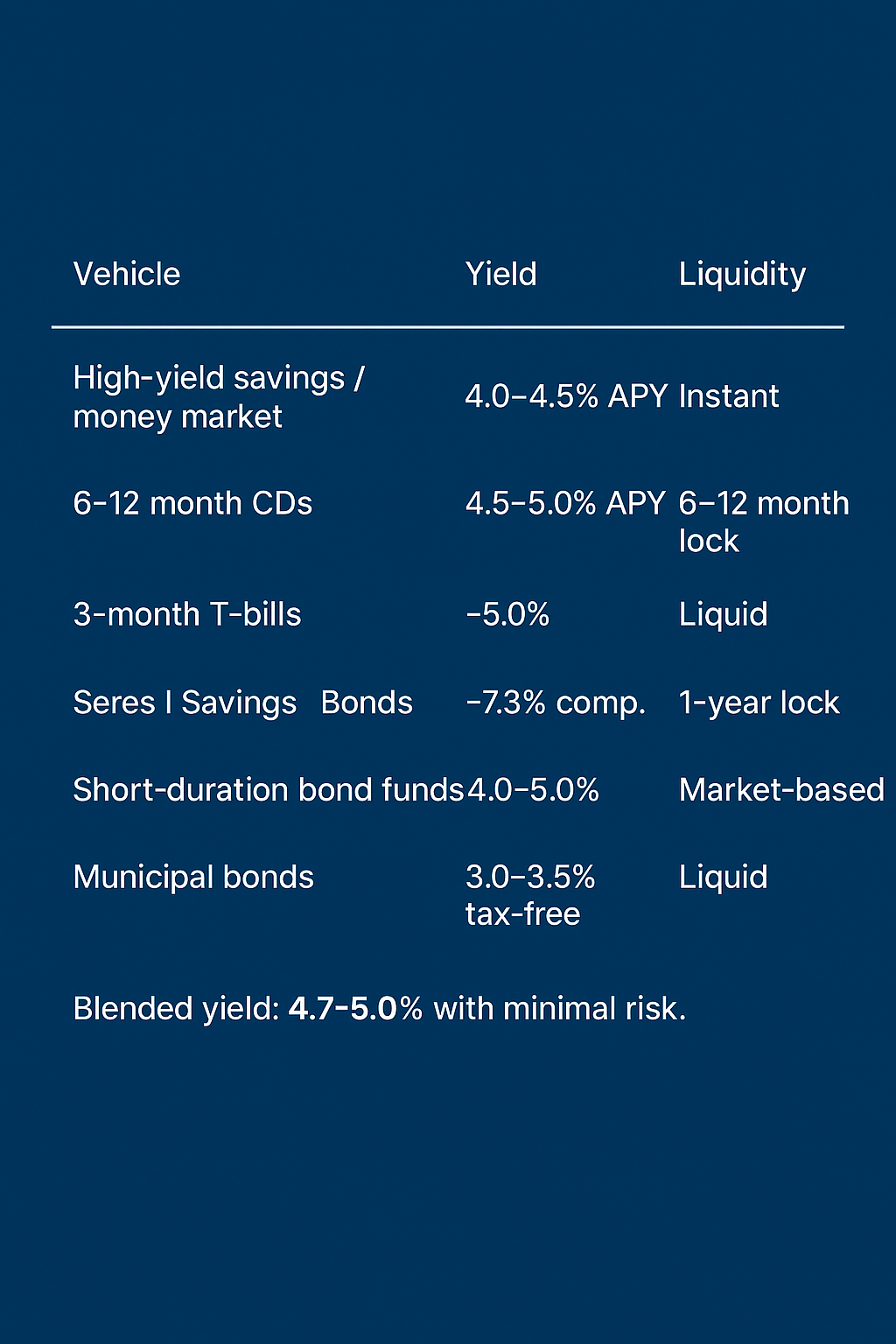Have you noticed the sudden avalanche of listings in San Diego’s most exclusive ZIP codes? April 2025 brought a surprising twist: ten high-end neighborhoods saw inventory jump by double digits, flipping the script from seller’s market to buyer’s delight.
Top 10 ZIPs by Year‑Over‑Year Inventory Growth
Looking at April 2024 to April 2025, these ZIP codes saw the biggest inventory surges (YOY), alongside their average home values and value changes:

Bottom 5 Constrained ZIPs by Year‑Over‑Year Inventory Growth
In contrast, these ZIP codes saw the smallest year‑over‑year inventory growth and show ongoing supply constraints, alongside their average home values and value changes:

Forecasts: Slow and Sure Gains Ahead
The pros agree on one thing: price appreciation will continue-but at a gentler pace:
Steven Thomas pegs national growth at ~2% for 2025, noting San Diego’s tight supply should keep values steady.
Zillow forecasts 2.5% gains in the San Diego–Carlsbad metro through late 2025.
Realtor.com is more enthusiastic (up to 9%), but most local advisors stick to a 2–4% annual range.
Luxury ZIPs with bloated inventories may lag, while entry- and mid-market sectors could outperform.
Are We at the Peak?
It’s tempting to ask “is this the top?” and the answer looks like a cautious “not quite”—but we’re definitely flirting with it:
Moderating appreciation: We’ve gone from 10–15% annual gains to forecasts clustered in the 2–4% range. That slowdown signals the party’s winding down.
Luxury inventory surge: A nearly 50% YOY jump in top-tier listings means more options for buyers and less price pressure at the high end.
Mortgage rate hangover: 6% loans on multimillion-dollar homes sting, cutting the buyer pool and capping upward momentum.
Seasonal rebound: Summer’s buying rush could soak up excess supply and squeeze out another 3–5% of gains—but expect a cooldown in fall.
Macro uncertainties: Fed moves, tax tweaks or a broader slowdown could tip us into flat or slight declines.
Bottom line: I wouldn’t grab the champagne just yet. If you’re buying now, lean into zip codes with proven demand—University City, Mission Valley, Oceanside—where absorption stays strong, and lock in financing before any rate relief triggers another buying stampede.
Local Economist Perspective
Steven Thomas of Reports on Housing emphasizes that the spring 2025 market is among the slowest on record in San Diego County, with mortgage rates nearing 7% and consumer sentiment dampened by tariffs creating affordability headwinds. He notes that while supply has surged—offering buyers unprecedented choice—success now hinges on “proper expectations and proper pricing” to navigate this uniquely sluggish spring market.
Silver Lining: Why There’s Hope
Despite the cooling signals, there are bright spots ahead:
Affordability reset: Moderated price gains (2–4% expected) mean more first-time buyers can enter the market, expanding the pool of qualified purchasers.
Favorable financing windows: If the Fed pivots and rates dip later this year, buyers standing by with pre-approved loans will enjoy instant leverage.
Strong fundamentals: San Diego’s job growth, robust renter demand, and limited developable land continue to underpin long-term value.
Innovation hubs: Growth in biotech, defense, and tech sectors—especially around University City and Sorrento Valley—will sustain housing demand and price support.
This blend of stabilized prices, potential rate relief, and solid economic drivers suggests the market isn’t crashing—it’s recalibrating for healthier growth.
Parking Cash vs. Buying Real Estate
Not convinced it’s time to lock into property? You can still earn 4–7% on safer assets today:

The Best Real Estate Plays Right Now
If you’re chasing growth + income, real estate still wins-but location is everything:
University City (92122): Biotech pros and scholars need furnished pads.
Mission Valley (92108): Transit-linked, high rental demand.
Pacific Beach (92109): Surf, sun, and steady leisure income.
Oceanside (92056): Affordable beach city with year-round demand.
Expect 2–4% price growth plus rental yields in the 5–6% range. Use leverage, find value-add opportunities, and your cash-on-cash returns could outpace conservative options.
Furnished Rental Hotspots
Fully furnished properties command a premium. Top zones:
University City: Lab coats by day, poolside by night.
Mission Valley: Loft living near SDSU.
Gaslamp/Downtown: Neon nights and corporate stays.
Pacific Beach: Surf shack vibes for tourists.
Hillcrest/North Park: Artsy retreats for medical staff.
La Jolla: Coastal chic for visiting scholars.
Oceanside: Beachside base for commuters and tourists.
Pick your lease term wisely-nightly rates or monthly contracts-and watch occupancy soar.
What’s Next?
Summer demand could absorb the extra luxury listings or push prices lower. Meanwhile, tight sub-$750K markets will stay red-hot. Your move: seize negotiation power where inventory spikes, or lock into inflation-hedging bonds if you prefer certainty.




